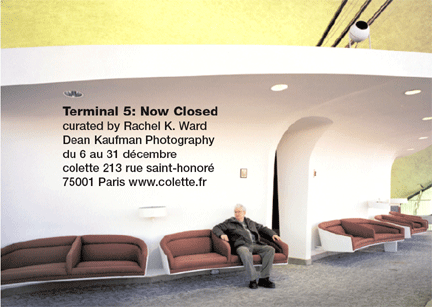
Do
not enter. This restriction is determined by an authority or a governor of a location.
Why are we prevented from entering locations? Some locations are reserved for
the elite, for those who could walk through any wall. Some locations are considered
dangerous; they are not measured safe and pose a risk to visitors. Other locations
are restricted for operations, they are places where items are stored or controlled.
We are not allowed to enter the control room; we are not supposed to stop the
machine; we are not to interfere with the locations of power.
At the
airport, we are stopped at each check point to present identification, to verify
that we are permitted to board an aircraft. These precautions are for our safety.
At a museum or an art gallery, however, anyone can enter, and this permission
is granted for our alleged cultural benefit.
At Colette, the gallery
is closed for entry. The space, normally open is now blocked; entry is prohibited.
The old garde has closed down the gallery before - Daniel Buren in 1969 with his
signature stripes on a gallery door and Dennis Oppenheim in 1971 with guard dogs
at the Met entrance. Today, Colette's gallery is closed as a protest against the
closure of the Terminal 5 exhibition at John F. Kennedy International Airport
in New York.
Terminal 5 was a group exhibition including work by Vanessa
Beecroft, Douglas Coupland, Dan Graham, Jenny Holzer, Ryoji Ikeda, Tom Sachs,
and others. The exhibition was installed into the jet age airport terminal designed
by Eero Saarinen. This terminal was operated and then abandoned by TWA in 2001.
The exhibition was presented in the vacant terminal with an opening event on October
1, 2004. At this event, a large crowd led to a minor security incident in which
a restricted door was opened. A "Do Not Enter" door was opened by a
guest. On October 5, 2004 at 12 noon the exhibition opened to the general public.
At 12:01 pm the Port Authority of New York and New Jersey closed the exhibition,
citing security causes from the opening event, such as the broken door.
Terminal 5 was open for 1 minute. This may be the shortest exhibition in recorded
history but more importantly, it is an incident in art and cultural history that
reveals our contemporary conditions of air travel and social space. The exhibition
in New York poses a risk; it takes place upon a threshold of power; it is too
dangerous to go without government control. The exhibition, with 19 artists from
10 countries, remains installed but closed and unseen by the public until the
Port Authority determines the outcome.
Within Colette's gallery, we
present documentation of Terminal 5 by Dean Kaufman. Kaufman has been photographing
the terminal from when we first entered the abandoned airport to when the exhibition
was installed and briefly open. His photographs are not to be seen. You are not
permitted to enter this gallery, to see this exhibition. This exhibition is veiled
in order to unveil the situation of socially constructed boundaries and of presenting
art in locations where we are told not to enter or even to look. The artist arbitrates
power, territory, and ideas - the systems that attempt to define boundaries of
liberty.
Restriction is also protection; permission is also surrender; protest suspends
power.
RKW,
2004